BPMN-Based Design of Multi-Agent Systems: Personalized Language Learning Workflow Automation with RAG-Enhanced Knowledge Access †
Abstract
1. Introduction
- A novel BPMN-to-MAS transformation methodology that converts pedagogical workflows into executable MAS, bridging formal process modeling with AI-driven education.
- Integration of RAG technology to ensure accurate, contextually grounded language instruction while mitigating LLM hallucinations.
- Implementation of a complete Luxembourgish learning platform (A1–B2) with React/FastAPI frontend, LangGraph core, ChromaDB vector store, and STT/TTS pipelines.
- Empirical evaluation showing strong response accuracy (RAGAs: Context Relevancy = 0.87, Faithfulness = 0.82, Answer Relevancy = 0.85) and high learner satisfaction in a pilot (85.8% ease-of-use, 71.4% engagement).
- A generalizable framework for low-resource language education that combines formal process modeling, distributed AI agents, and knowledge-grounded generation.
2. Related Work
2.1. BPMN for Educational Process Modeling
2.2. Multi-Agent Systems in Education
2.3. Retrieval-Augmented Generation
2.4. LLM-Powered Language Learning Chatbots
2.5. Technologies for Low-Resource Languages
2.6. Research Gap
- Uses BPMN to specify pedagogical workflows.
- Orchestrates specialized LLM-powered agents via MAS.
- Grounds all content in vetted external knowledge with RAG.
- Incorporates real-time voice interaction (STT/TTS) for a low-resource language.
3. System Design and Architecture
- BPMN for Workflow Modeling: BPMN is used to define and structure the high-level learning workflow, where each task represents a discrete, pedagogically motivated educational activity (e.g., “Grammar Practice” or “Listening Drill”). This visual modeling ensures that the learning journey is transparent, auditable, and adaptable. For example, a gateway in the BPMN diagram may check a learner’s comprehension score before deciding whether to proceed to the next module or trigger a remedial loop. This workflow specification is language-agnostic: replacing the underlying content source (e.g., Luxembourgish INL materials) with another language corpus automatically adapts the curriculum while preserving the pedagogical logic.
- MAS for Process Execution: The BPMN workflow is executed by a Multi-Agent System where each agent is domain-specific and optimized for a specific pedagogical role. Instead of a single, monolithic LLM, specialized agents (Conversational, Grammar, Reading, Listening) operate in parallel and exchange structured messages. This allows the platform to replicate the modularity of Luxembourgish textbooks, in which activities are clearly separated by skill type, and to allocate computational resources more efficiently. In our current implementation, MAS orchestration is built specifically on LangGraph to leverage its graph-based state management and node orchestration capabilities. While the BPMN definitions and pedagogical design could be reused, the execution layer is optimized for LangGraph’s architecture.
- RAG for Knowledge Grounding: Each agent is connected to a Retrieval-Augmented Generation pipeline that provides access to vetted educational content. Using vector stores built from OCR-processed INL textbooks, the agents retrieve semantically relevant chunks to anchor their output in authoritative material. This prevents hallucinations, aligns answers with CEFR-level objectives, and maintains consistency across sessions. While our pilot uses INL Luxembourgish resources, the RAG pipeline can be rebuilt from any approved corpus in another language or subject area, making the approach applicable well beyond Luxembourgish.
3.1. Description of the Architecture Workflow
- Vector Store Preparation (top of the diagram): The first step occurs before interaction with learners. Content is extracted from scanned INL textbooks using OCR via ChatGPT Vision, which outputs transcribed text and descriptions of embedded images. The Splitter Agent then divides this material into semantically coherent chunks, while the Organizer Agent enriches each chunk with metadata (Thema, activity type, intended tutor agent). The annotated chunks are embedded into dense vectors and stored in the vector database. This repository constitutes the knowledge base for Retrieval-Augmented Generation (RAG).
- MAS Architecture (bottom of the diagram): During live sessions, the Communicator Agent collects the learner profile (level, past progress, preferences) and provides recommendations on relevant learning content. This information is passed to the Orchestrator Agent, which validates retrieved content with the teacher, plans the work order, prepares the learning environment, and sequences activities. The orchestrator then calls the Tracker Agent, whose role is to ensure correct execution order, signal the appropriate tutor agent, and monitor workflow progression. Each Tutor Agent (Conversational, Reading, Listening, Q&A, Grammar Summary) receives the selected content chunk as input, delivers the activity to the learner, and outputs updated progress and performance indicators, which are reintegrated into the learner profile.
- Inputs and Outputs: For clarity, inputs and outputs are now described explicitly:
- The input of the Vector Store Preparation pipeline is raw textbook content (text + images); its output is an embedded, metadata-enriched vector store.
- The input of the Communicator Agent is the learner profile; its output is a recommendation about learning content.
- The input of the Orchestrator Agent is the learner profile and validated content; its output is an ordered pedagogical sequence.
- The input of the Tracker Agent is the orchestrator’s plan; its output is signals to tutor agents and execution logs.
- The input of each Tutor Agent is a content chunk; its output is updated learner progress and performance data.
3.2. Core Agent Roles and Responsibilities
3.2.1. Core Agents
- (A)
- Communicator AgentActs as the system’s primary entry point for the learner. It collects and updates the learner profile (e.g., CEFR level, preferred learning style, past performance), recommends activities tailored to their needs, and establishes the learning path. This agent justifies its role by ensuring that no session begins without a pedagogically relevant and personalized plan. Its logic is independent of language or domain—profiles can store any set of learner metadata, making it adaptable for other subjects or languages by replacing the content retrieval layer.
- (B)
- Orchestrator AgentServes as the “session director,” reading the BPMN workflow, retrieving the correct content for each step via RAG, and sequencing activities in pedagogically meaningful ways. Its existence is essential to guarantee that content flows logically (e.g., listening before speaking practice) and that agents receive the exact context they need. Since it consumes BPMN definitions, the same Orchestrator can execute any compliant process model, enabling reuse across institutions or curricula with different content sources.
- (C)
- Tracker AgentEnsures that the session is executed in the correct order and that no activity is skipped. It waits for each tutor agent to finish before activating the next one, logs task completion, and maintains timing constraints. This agent exists to maintain session integrity and support explainability by providing a clear execution trace. The Tracker Agent’s state management relies on LangGraph’s graph execution model, meaning that preserving identical execution integrity would require using LangGraph or an equivalent graph-based orchestration engine.
- (D)
- Specialized Tutor AgentsThese agents map directly to the main skill areas in language learning and replicate textbook activity types. Each has a unique role:
- Conversational Agent: Simulates real-life dialogue, conducts role-plays, and evaluates spoken language. It uses STT to assess pronunciation and fluency, re-prompts after repeated pronunciation errors, and expands vocabulary through contextual use. This agent exists to address the speaking component of the CEFR framework.Its STT/TTS pipeline can be switched to open-source models (e.g., Whisper, Vosk) or commercial APIs in any target language.
- Reading Agent: Presents texts, checks comprehension through summaries or questions, and introduces vocabulary in context. It is triggered when BPMN conditions indicate a need for reading comprehension improvement.Adaptation to other languages simply requires a corpus with aligned reading materials and CEFR-like difficulty labels.
- Listening Agent: Plays audio excerpts, transcribes learner responses, and provides corrective feedback on recognition errors. It repeats audio when comprehension thresholds are not met.This agent supports any audio format and can be integrated with multilingual STT engines to extend coverage beyond Luxembourgish.
- QA Agent: Presents exercises (fill-in-the-blank, multiple-choice) modeled after “Kombinéiert!” and “Notéiert!/Schreift!” activities. It provides targeted hints after wrong answers and re-tests the learner before moving on.Exercise templates are generic and can be automatically populated from different datasets, enabling domain transfer.
- Grammar Summary Agent: Explains grammar rules, answers learner questions, and runs short practice drills. This agent is called after BPMN gateways detect consistent grammar errors in conversation or writing exercises.Grammar explanations are sourced from the RAG knowledge base, allowing immediate substitution of language-specific rules for other target languages.
- (E)
- Human TutorA teacher will be involved to ensure the linguistic accuracy and coherence of the learning materials. This includes verifying the alignment between text content, audio transcriptions, and visual illustrations. The teacher also validates the relevance and pedagogical sequencing of the content retrieved by the Orchestrator, ensuring it is appropriate for the user’s proficiency level and learning objectives. Beyond quality control, the human tutor serves as a critical human-in-the-loop validation layer: they review AI-generated outputs for both correctness and cultural appropriateness, confirm that exercises are aligned with CEFR progression goals, and provide feedback for refining agent prompts and workflow logic. This role ensures that automated decisions remain pedagogically sound, maintain learner trust, and adapt appropriately to edge cases where AI recommendations may not fit the learner’s individual needs. In deployments outside Luxembourgish, this role can be filled by subject matter experts in the relevant language or domain, making the validation process universally applicable.
3.2.2. Knowledge Provenance
- Thema (topic title, e.g., “Wéi heescht Dir?”).
- Kategorie (activity type, e.g., “Dialogs and name spelling exercises”).
- Agent (the intended tutor agent for delivery).
- Inhalt (verbatim learning content from the textbook).

3.2.3. Human Auditing
- The raw BPMN-defined sequence of activities to confirm the intended pedagogical flow.
- LangSmith logs capturing the exact decision context for each agent’s action.
- The alignment between chunk metadata and delivered exercises, ensuring that each exercise is both relevant and level-appropriate.
3.2.4. Workflow Transparency
- Developers to understand and debug complex agent interactions without needing to interpret raw code.
- Instructors to verify that system behavior aligns with pedagogical best practices.
- Auditors to confirm that decision logic is explicit, deterministic, and traceable.
3.3. Explainability Mechanisms
LangSmith Role
- Explore complete prompt histories for each agent node to understand how the model was instructed.
- Inspect intermediate state variables and message payloads to trace decision dependencies.
- Visualize conditional routing paths and loop iterations, making execution flow easy to follow.
- Search and filter on specific student interactions or decision predicates for targeted review.
- Simplifies technical debugging for developers.
- Facilitates pedagogical review for educators.
- Supports compliance and accountability for institutional oversight.
3.4. Pedagogical and Methodological Fit
- CEFR and Mastery Learning: BPMN activities map to CEFR skills (speaking, listening, reading, grammar). Gateways implement criterion thresholds (e.g., comprehension or pronunciation scores) to trigger remediation, operationalizing mastery learning.
- CLT/TBLT: The Conversational Agent delivers communicative tasks (role-plays, turn-taking). The QA and Grammar Summary agents provide focus-on-form within meaningful interaction, consistent with communicative and task-based language teaching.
- UDL (Universal Design for Learning): STT/TTS offer multimodal access (input/output). BPMN loops support variable pacing and multiple means of engagement; RAG curates level-appropriate materials for multiple means of representation.
- ADDIE as Executable Workflow: BPMN captures Analyze/Design/Develop/Implement/Evaluate. The Tracker and human-in-the-loop validation close the E (Evaluate) phase with logs and feedback, feeding iterative redesign.
- Evidence-Centered Design (ECD): The Tracker’s logs and agent outputs form the evidence model; BPMN tasks define the task model; learner state variables constitute the student model. RAG provenance improves the validity of observed evidence.
- Formative Assessment: QA hints, re-tries, and remedial branches provide continuous formative feedback and data for next-step decisions.
4. BPMN to MAS Transformation
4.1. BPMN Modeling of Learning Workflows
4.1.1. Top-Level Orchestration Diagram (Figure 3)
- Start Event (Message): The User logs in, triggering a message start event in the Communicator lane.
- User Data Retrieval (Service Tasks): In the Communicator lane, three service tasks are retrieved:
- UserProfile: personal details and learning objectives.
- LatestProgressFile: feedback from the previous session.
- CurriculumOutline: textbook TOC matching the user’s proficiency.
- Personalized Path Generation: A service task builds a LearningPathRecommendation. A message flow delivers it to the User, and an exclusive gateway (“Accept?”) loops back for refinement until approval.
- Query Generation and Dispatch: Once approved, the Communicator constructs a RAGQuery (including topic IDs and proficiency level) and sends it as a message to the Orchestrator.
- Content Retrieval and Validation: The Orchestrator executes a VectorStoreLookup against ChromaDB, then sends the retrieved material to the Human Teacher for validation (message task) and awaits approval.
- Workflow Planning: A parallel gateway splits into two branches:
- Assign each content chunk to its appropriate Tutor Agent.
- Build the SequenceReport specifying agent invocation order.
Both branches join before proceeding. - Report Emission: Two tasks are called:
- ContentReport→ Tracker (mapping agents to content).
- SequenceReport→ Tracker (ordered list of agents).
- Tutor Invocation Loop: In the Tracker lane:
- DetermineNextAgent via SequenceReport.
- Send StartSession message to that Tutor Agent.
- Wait (intermediate catch event) for EndSession or EarlyExit.
- Log progress (partial or complete).
Repeat until no agents remain. - End Event: Once all sessions finish, the Tracker emits an end event. The UI displays the updated progress dashboard and may loop back to the Communicator for a new cycle.
- User Credential Submission: Input = learner login data; Output = verification signal. Justified as a prerequisite for linking activities to an individual profile and ensuring continuity of progress tracking.
- Profile, Progress, Curriculum Retrieval: Input = database queries; Output = structured learner state (profile, last progress, curriculum). These steps guarantee that personalization is based on actual learner history rather than generic defaults.
- Learning Path Recommendation: Input = learner state; Output = a personalized path proposal. Justified as the mechanism that maintains learner agency (accept/modify recommendations) while ensuring pedagogical alignment.
- RAG Query Generation: Input = approved recommendation; Output = structured query (topic, level, context). This ensures retrieved material is both content-relevant and level-appropriate.
- Content Retrieval and Validation: Input = RAG query; Output = validated content chunks. Human-in-the-loop validation is critical to prevent propagation of errors or culturally inappropriate material.
- Workflow Planning (Parallel Gateway): Input = validated content; Outputs = (a) tutor-content mapping, (b) execution sequence. This guarantees both correct specialization (each tutor gets the right chunk) and logical sequencing (skills taught in a pedagogically sound order).
- Report Transmission: Input = planning results; Output = content and sequence reports sent to the Tracker. Justified as an explainability feature—each decision is made explicit and logged.
- Tutor Invocation Loop: Input = sequence report; Output = session execution logs. By enforcing strict sequencing and waiting for explicit completion events, this loop prevents skipped steps and enables auditing of learner-agent interactions.
- Session Termination and Feedback: Input = last tutor outputs; Output = updated learner progress and dashboard update. This ensures that every session closes with measurable outcomes and an updated profile for the next cycle.
4.1.2. BPMN Diagrams for Tutor Agents
- Example: Conversation Agent (Figure 5)
- Message Start: Catch StartSession from Tracker.
- Fetch Content: Load dialogue script and role definitions from ContentReport.
- Introduction: Outline session goals (e.g., focus on past tense).
- Role-Play Loop:
- Prompt user with their first line.
- Send spoken reply to STT; receive transcription.
- Gateway G1 (Correct?):
- –
- If correct, advance to next line.
- –
- If incorrect, provide corrective feedback and loop back.
- Repeat until all turns are complete.
- Wrap-Up: Summarize key vocabulary and structures; write progress fragment.
- Message End: Send EndSession + progress payload back to Tracker.
4.1.3. Overview of Other Tutor Agents
- Reading Agent (Figure A1): Presents text to read, checks pronunciation via STT, requests a spoken or written summary, evaluates comprehension, teaches new vocabulary, and loops until mastery.Gateway R1: IF summary_correct? → continue; ELSE → replay text + re-question.Gateway R2: IF comprehension_score > threshold → next activity; ELSE → vocabulary drill.
- Listening Agent (Figure A2): Plays audio clips, prompts learner reproduction, transcribes and evaluates responses, offers vocabulary tips, and loops for reinforcement.Gateway L1: IF transcription_accuracy > 80% → next clip; ELSE → replay clip.Gateway L2: IF vocab_usage_correct? → continue; ELSE → provide targeted vocabulary drill.
- QA Agent (Figure A3): Displays exercises (fill-in, MCQ), evaluates answers, provides hints on incorrect responses, and summarizes learning goals.Gateway Q1: IF answer == key → correct flow; ELSE → hint task + retry.Gateway Q2: IF retry_count > 2 → escalate to Grammar Summary Agent; ELSE → loop for another attempt.
- Grammar Summary Agent (Figure A4): Reviews previous grammar, elicits user questions, explains rules, engages in practice sentences, identifies errors, and closes with a concise rule summary.Gateway Gs1: IF user_asks_question → answer question; ELSE → present practice sentence.Gateway Gs2: IF error_count > 3 → trigger additional examples; ELSE → proceed to summary.
4.2. Mapping BPMN to MAS
4.2.1. Agent and Tool Nodes
4.2.2. Routers and Conditional Edges
4.2.3. Message Passing
4.2.4. Example: Communicator Routing
- Loop back to itself (Continue) if the learner requests adjustments.
- Invoke its communicator_call_tool node (Call tool) to re-fetch profile data.
- Transition to the Orchestrator node (Go orchestrator) once the recommendation is approved.
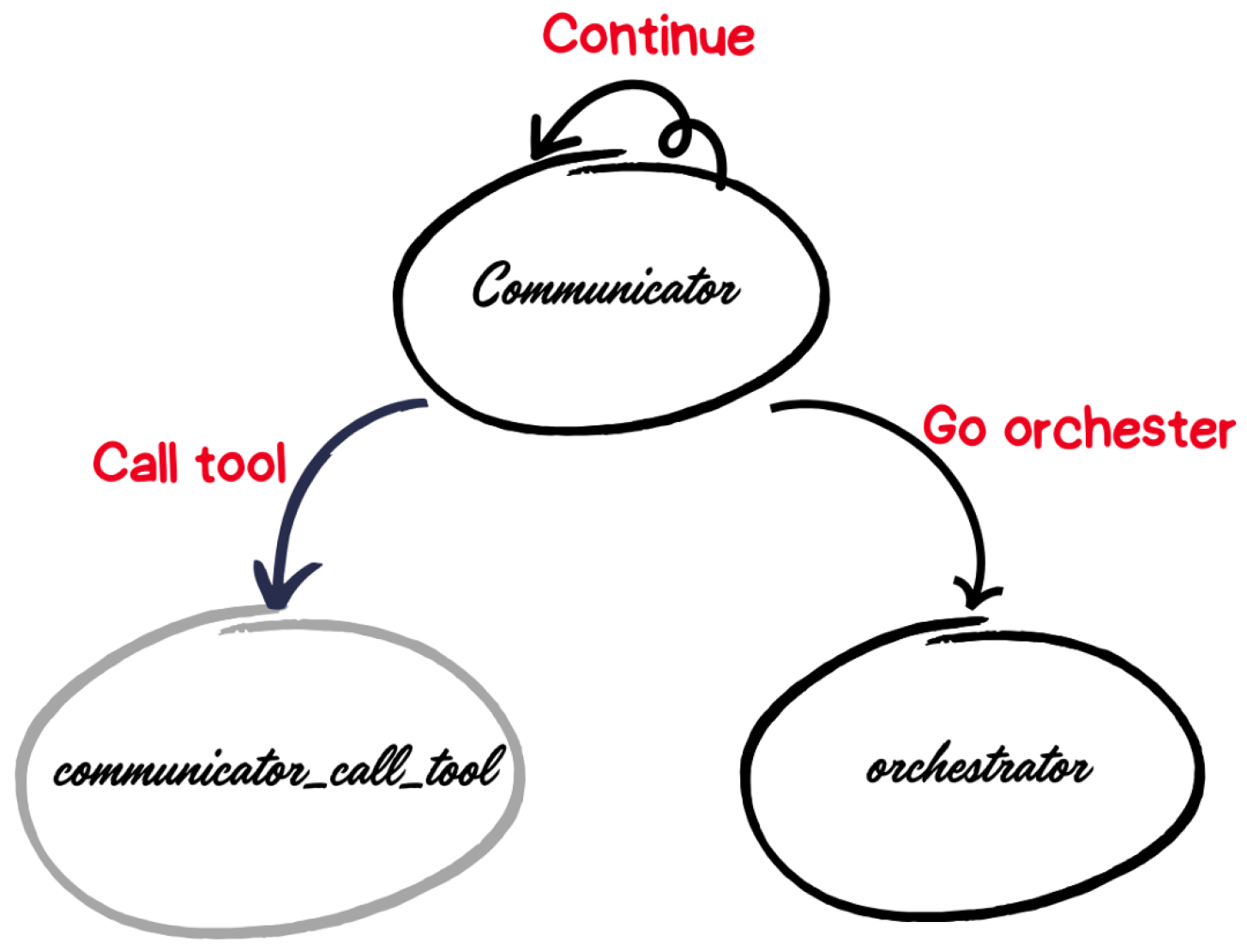
4.2.5. Handling Multiple User Inputs
4.3. Multi-Agent Architecture
- Communicator Agent: First interface with users, providing personalized recommendations based on learner profiles and progress.
- Orchestrator Agent: Manages workflow, retrieves relevant content, and coordinates agent activation.
- Tracker Agent: Monitors workflow execution and learner progress.
- Tutor Agents: Specialized agents for different learning aspects:
- –
- Conversational Agent: Facilitates speaking practice.
- –
- Reading Agent: Guides reading comprehension.
- –
- Listening Agent: Manages listening exercises.
- –
- QA Agent: Handles interactive questions.
- –
- Grammar Summary Agent: Provides grammatical explanations.
- Human Validator: Reviews and approves generated content.
4.4. LangGraph Implementation and Prompt Orchestration
4.4.1. LangGraph Architecture
- Nodes:
- Each node represents a computation phase, often an LLM-driven task executor. Nodes process user inputs, generate or transform text, invoke external tools (e.g., RAG lookups, STT/TTS), and update shared state.
- Edges:
- Unconditional edges define fixed sequences, while conditional edges evaluate predicates (e.g., “user accepted recommendation?”) to branch dynamically.
- Task Looping: Nodes may loop to themselves until a gateway condition is satisfied.
- Conditional Routing: Router nodes inspect state or outputs and select the correct outgoing edge.
- Persistent State Management: Message payloads and node states persist across turns, so each agent “remembers” prior context.
4.4.2. Prompt Engineering for Agent Behavior
- Clarity and Role Definition: “You are the Conversational Agent tasked with…”
- Stepwise Instructions: Numbered or bullet steps guide the model through its workflow.
- Contextual Anchoring: Inject RAG-retrieved content chunks to ground responses.
- Error Handling: Include conditional clauses (e.g., “If the user’s answer is incorrect, provide feedback and re-prompt”).
- Iterative Refinement: Collect performance metrics after each session and refine prompts to reduce ambiguity and hallucinations.
4.4.3. Integrating Prompts into Nodes
4.4.4. Example Prompt Templates
- Listing A1: Communicator Agent system message, showing role definition and basic RAG context setup.
- Listing A2: Conversational Tutor Agent prompt, including:
- –
- Role Definition (“You are a Conversational Agent…”).
- –
- RAG Context Injection (e.g., Thema: "Wéi heescht Dir?", Kategorie: "Dialogs", Agent: "Conversational”).
- -
- Error-Handling Logic (e.g., “IF user_error THEN provide corrective feedback and re-prompt”).
4.4.5. Graph Compilation and Execution
- The __start__ node dispatches control to communicator.
- communicator interacts with the learner (loop/tool/orchestrator branches).
- orchestrator retrieves RAG content, validates with the teacher, and signals tracker.
- tracker sequentially activates each tutor agent (reader, listening, questionAnswering, grammarSummary), awaiting each EndSession.
- After all tutor nodes complete, tracker issues __end__, concluding the session.
4.5. Voice Integration: STT and TTS
4.5.1. Speech-to-Text (STT)
4.5.2. Text-to-Speech (TTS)
- Data Source: lb-de-fr-en-pt-12800-TTS-CORPUS (12,800, WAV samples @16 kHz, 18 speakers, five languages including Luxembourgish).
- Model: lb-de-fr-en-pt-coqui-vits-tts, a multilingual, multi-speaker VITS model fine-tuned on the above corpus. VITS combines GANs and VAEs in an end-to-end TTS architecture, requiring no external alignments.
- Results and Selection: Fine-tuned Coqui VITS [57] produced natural, intelligible Luxembourgish speech, outperforming MaryTTS-based alternatives. Given its high quality and the lack of superior open models, we adopt Coqui VITS for all agent voice output.
4.5.3. Integration into Multi-Agent Workflow
4.5.4. STT/TTS Integration
- wav2vec2-large-xlsr-53-842h-luxembourgish-14h: A multilingual model pre-trained on 53 languages and fine-tuned with 842 h of unlabeled plus 14 h of labeled Luxembourgish speech, which achieved a WER of 28%.
- whisper_large_lb_ZLS_v4_38h: OpenAI’s Whisper base model, further fine-tuned on 38 h of labeled Luxembourgish data by the Zentrum fir d’Lëtzebuerger Sprooch (ZLS), which achieved a superior WER of 18%.
5. RAG-Enhanced Knowledge Base
5.1. Why RAG for Low-Resource Languages
- Relevance: Retrieving domain-specific content (INL textbooks) tailored to each learner’s level.
- Accuracy: Anchoring generation in factual excerpts, bolstering learner trust.
- Pedagogical Alignment: Dynamically selecting material that matches Common European Framework of Reference for Languages (CEFR) aligned chapters and topics.
5.2. RAG Pipeline
5.2.1. Retrieval
- Document Preparation:
- Scan INL textbooks (A1–B2) and convert pages to Markdown via GPT-4 Vision OCR [59].
- Clean and normalize text (remove headers/footers, correct OCR errors).
- Chunking and Splitting: We employ agentic chunking to mirror textbook structure:
- Splitter Agent: Divides each topic into semantically coherent “learning blocks.”
- Organizer Agent: Groups blocks by chapter and topic, preserving pedagogical order.
- Embedding and Storage: Each chunk is embedded and stored in ChromaDB [60]. We selected bge-large-en-v1.5 after benchmarking on MTEB and our pilot RAGAs evaluation as the best trade-off between latency, relevance, and open-source licensing.
5.2.2. Generation
- Query Embedding and Matching: Learner queries or agent prompts are embedded and matched against stored vectors via cosine similarity to retrieve the top-k chunks.
- Contextual Response: Retrieved chunks are prepended to the LLM prompt (e.g., GPT-4), which generates the final answer, reflecting both the model’s internal knowledge and the verified textbook content.
- Explainability Tags: Each response includes semantic source metadata drawn from chunk fields: [Source: Thema=“Wéi heescht Dir?”, Kategorie=“Dialogs”, Agent=“Conversational”] enabling learners and educators to verify content against original materials.
5.3. Embedding Model Selection
- Latency: Time to embed the full INL corpus (e.g., text-embedding-3-large completed in ≈53 s, while others averaged ≈ 3 h).
- Relevance (RAGAs): Performance on context relevancy, faithfulness, and answer relevancy.
5.4. Evaluation with RAGAs
- Context Relevancy.
- Context Precision.
- Context Recall.
- Faithfulness.
- Answer Relevancy.
- Answer Correctness.
5.5. Building a Robust Knowledge Base
6. Implementation and Use Case
6.1. Technology Stack
- Frontend: React.js, renders the learner dashboard, chat interface, and course navigation, and streams audio via Web Audio API.
- Backend: FastAPI (Python), exposes REST and WebSocket endpoints for user authentication, agent orchestration, and real-time messaging.
- Core Agents: Implemented with LangGraph on top of LangChain, compiles BPMN-derived workflows into a stateful directed graph of TaskNodes and ToolNodes.
- RAG Vector Store: ChromaDB, stores pedagogically chunked INL content; queried via cosine-similarity retrievers.
- STT/TTS: OpenAI Whisper (whisper_large_lb_ZLS_v4_38h) for transcription; Coqui VITS (lb-de-fr-en-pt-coqui-vits-tts) for speech synthesis.
6.2. End-to-End Workflow
- The Communicator:
- Retrieves the user’s profile, progress, and curriculum metadata.
- Constructs and displays a personalized learning path in the React UI.
- Upon learner approval, emits a go_orchestrator event.
- The Orchestrator Agent then performs the following:
- Queries ChromaDB for the next topic’s content.
- Sends the raw material to a human teacher for quick validation (teacher-in-the-loop).
- Builds two reports: (i) validated content for tutor agents and (ii) the ordered list of agent tasks.
- Emits continue_to_tracker.
- The Tracker Agent:
- Parses the sequence report and dispatches start signals to each Tutor Agent in turn.
- Listens for each agent’s completion or exit signals.
- Aggregates intermediate progress and updates the learner’s profile.
- Each Tutor Agent: (Conversational, Reading, Listening, Grammar, Q&A) runs its BPMN-modeled activity diagram as a LangGraph TaskNode:
- It fetches its specific content from the Orchestrator’s report.
- Interacts with the learner via WebSocket streams (text + STT/TTS audio).
- Sends real-time feedback and performance metrics back to Tracker.
- Loops or branches as defined by the BPMN gateways.
6.3. Demonstration Highlights
- Learner dashboard flows in React,
- Chat-based dialogues powered by Conversational Agent.
- Listening exercises with real-time transcription.
- Grammar drills and Q&A sessions reflecting adaptive branching.
7. Evaluation
7.1. Response Accuracy with RAGAs
7.2. System Effectiveness and Learner Experience
- Ease of Interaction: 85.8% found the chatbot Very Easy or Easy.
- Satisfaction: 71.5% were Satisfied or Very Satisfied with contextual responses.
- Engagement: 71.4% rated the experience as Very engaging.
- Continued Use: 85.7% are Likely or Very Likely to continue using the system.
7.3. Usability and Pedagogical Alignment
- Responsive Interface: Login/dashboard, chat sessions, and progress tracking.
- Agent Workflows: Automatic sequencing of Conversational, Reading, Listening, Q&A, and Grammar agents via BPMN-defined flows.
- STT/TTS Integration: Whisper-based speech recognition (18% WER) and Coqui VITS TTS for immersive voice interaction.
7.4. Conclusion of the Evaluation
7.5. Limitations
- Model Dependencies: Performance relies on proprietary LLMs (GPT-4) and Whisper STT, limiting control over updates and accessibility for resource-constrained institutions. However, these components can be replaced with open-source alternatives that offer similar capabilities to ChatGPT and Whisper, ensuring the architecture remains usable in fully open-source deployments.
- Human Validation Bottleneck: Teacher-in-the-loop content approval, while ensuring accuracy, creates scalability challenges for large learner groups.
- Luxembourgish Specificity: Evaluations focused solely on Luxembourgish; generalizability to other low-resource languages with non-Latin scripts (e.g., Uralic or Bantu languages) remains unverified.
- Short-Term Engagement Metrics: Pilot studies measured immediate usability but not long-term proficiency gains (e.g., CEFR progression over 6+ months). Additionally, the pilot study’s small sample size (n = 14) should be increased in future studies.
- No Control Group: The pilot did not include a control group for comparison against alternative teaching methods or non-MAS language learning tools. This was due to time and resource constraints in the current study design. Future evaluations will incorporate control and experimental groups to enable statistically robust comparisons of learning outcomes.
8. Conclusions and Future Work
- Automate BPMN Generation: Develop tools to derive BPMN diagrams directly from curriculum specifications or learning objectives, reducing manual modeling effort.
- Broaden Curriculum Coverage: Extend our pipeline to additional CEFR levels (C1–C2) and subject domains (e.g., business, technical language).
- Enhanced Teacher-in-the-Loop: Introduce richer interfaces and analytics dashboards for instructors to review, adjust, and annotate agent workflows and content.
- Adaptive Learning Algorithms: Integrate reinforcement learning and learner modeling to personalize task sequencing dynamically based on real-time performance data.
- Longitudinal Studies: Conduct extended field trials across diverse learner populations and languages to evaluate long-term efficacy, retention gains, and transfer to real-world communication.
- Improve Explainability: Develop teacher-facing dashboards to visualize BPMN execution logs and RAG source attributions, enhancing real-time explainability. Applying model-agnostic XAI methods could be considered, such as Local Interpretable Model-agnostic Explanations (LIME) for text and SHapley Additive exPlanations (SHAP) for transformers.
Author Contributions
Funding
Institutional Review Board Statement
Informed Consent Statement
Data Availability Statement
Acknowledgments
Conflicts of Interest
Appendix A. BPMN Diagrams for Tutor Agents (Reading, Listening, Question Answering, and Grammar and Summary)
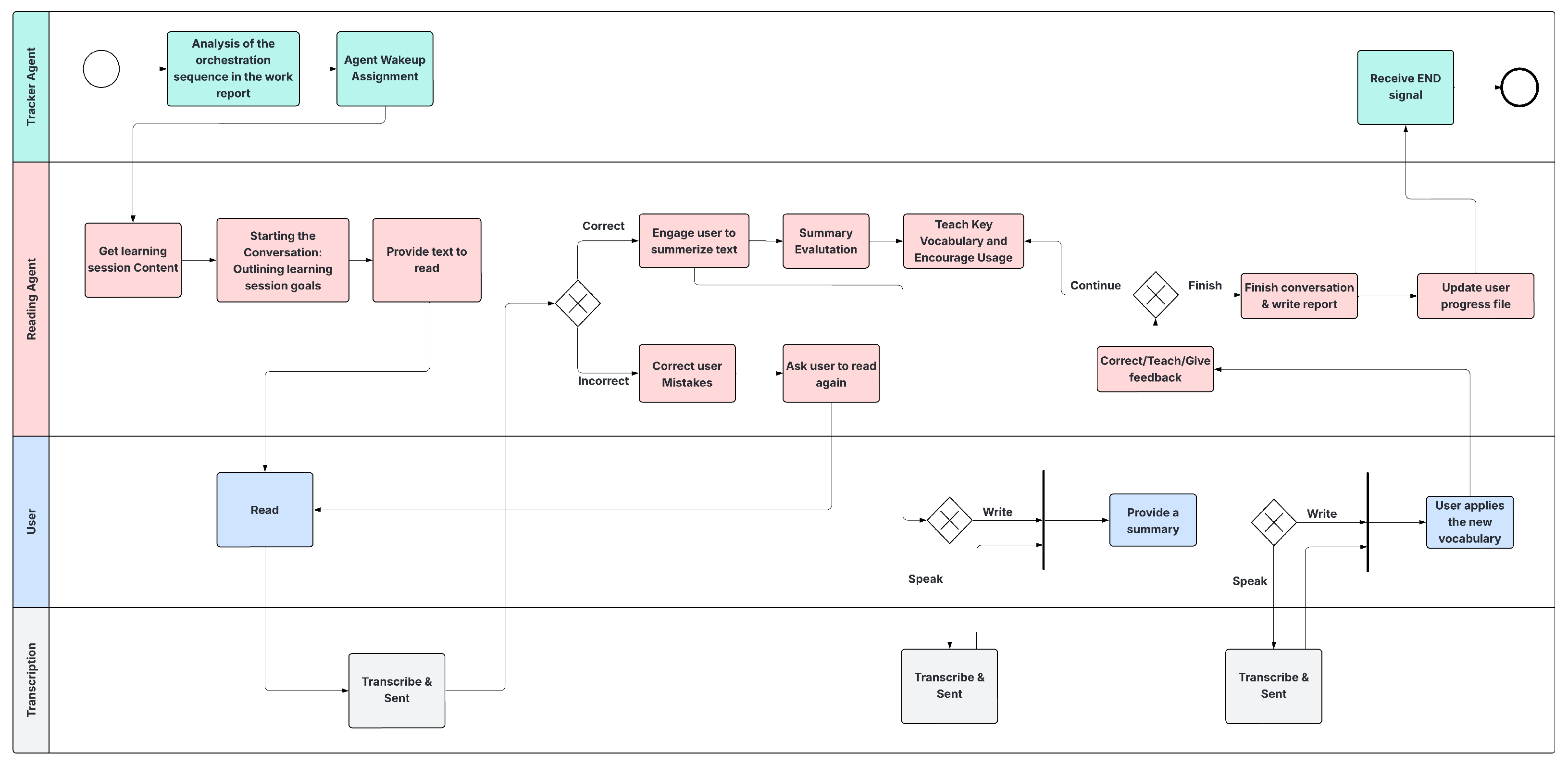


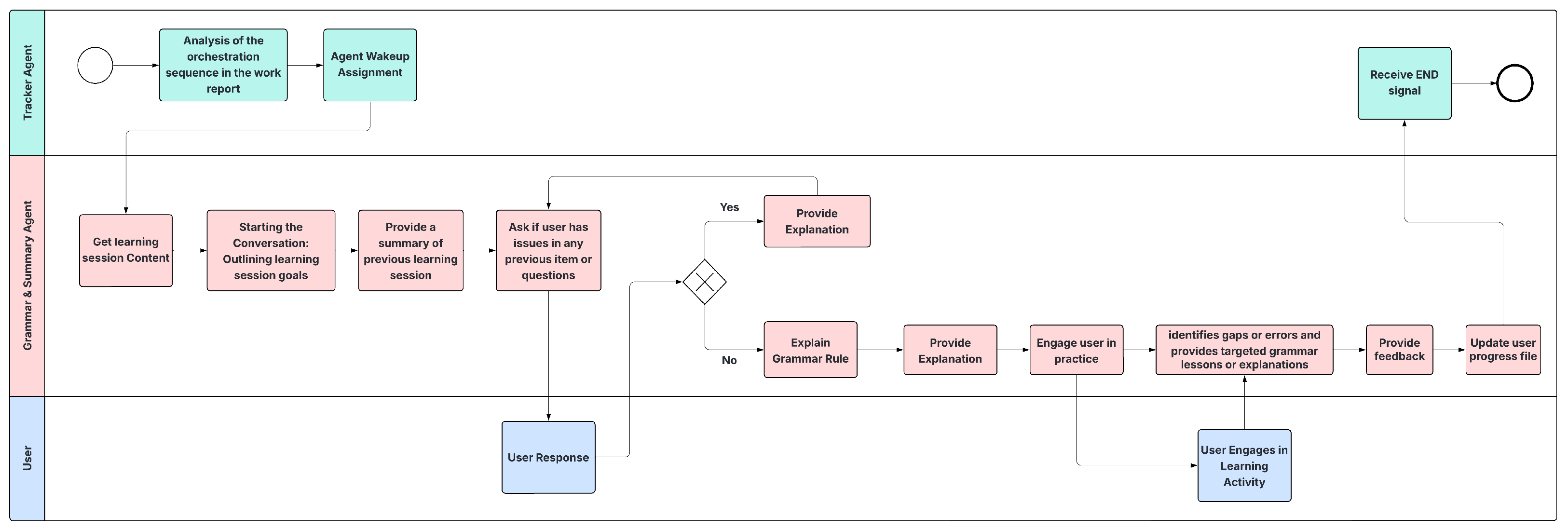
Appendix B. Sample Prompt Templates
system_message="You are the communicator agent, your job is to
communicate with the user in Luxembourgish to generate
a learning recommendation for them"
Conversational_Agent_Prompt = """
Dir sidd en digitalen Tutor, spezialiséiert op Sproochléieren
mat vill Erfahrung, besonnesch an der konversationeller Praxis.
Äert Zil ass et, d’Benotzer duerch effektivt Sproochléieren
mat engem konversationellen Usaz ze féieren.
Follegt dës Instruktioune fir dëst z’erreechen:
1. Léierziler setzen:
- Fänkt un, d’Léierziler ze erklären op Basis vum Inhalt,
deen ofgedeckt gëtt.
2. Wierderbuch an Notzung:
- Bedeelegt Iech un Gespréicher, erkläert de benotzte
Wierderbuch a motivéiert de Benotzer nei Wierder ze soen
oder se an Sätz ze benotzen.
3. Rollenspill:
- Féiert Rollenspillübungen duerch:
- Definéiert de Fokus vum Gespréich.
- Spezifizéiert Är Roll an d’Roll vum Benotzer.
- Gitt dem Benotzer e Signal fir unzefänken.
4. Evaluatioun a Feedback:
- Evaluéiert d’Äntwerte vum Benotzer grammatesch,
syntaktesch an a puncto Aussprooch.
- Wann d’Äntwert korrekt ass, spillt Är Roll.
- Wann d’Äntwert falsch ass, spillt d’Roll vum Tutor,
korrigéiert de Benotzer, gitt Hinweise an Tipps, dann
spillt Är Roll.
5. Resumé an Nofro:
- Resuméiert d’Gespréich, hebt neie Wierderbuch ervir, an
erkläert wéi een en benotzt.
- Frot de Benotzer, ob se méi Beispiller wëllen oder
schléit besser Äntwerten a Wierderbuch vir.
6. Feedback ginn:
- Gitt ëmmer Feedback iwwer dat, wat de Benotzer geléiert
huet an un wat se schaffe sollten.
7. Fortschrëttsbericht:
- Schreift e Bericht iwwer de Fortschrëtt vum Benotzer:
- Resuméiert, wat se erfollegräich geléiert hunn.
- Hieft Beräicher ervir, un deenen se schaffe mussen.
- Identifizéiert all Schwiriegkeeten, déi se beim
Léiere haten.
Huelt Iech e Moment Zäit an schafft methodesch un all
Schrëtt, benotzt de bereetgestallten Inhalt als Referenz fir
ze léieren an nei Léiermaterialien ze generéieren, a
kontrolléiert ëmmer, ob de Benotzer Iech follegt.
"""
You are a digital tutor specializing in language learning
with extensive experience, especially in conversational
practice. Your goal is to guide users through effective
language learning using a conversational approach. Follow
these instructions to achieve this:
1. Set Learning Objectives
— Begin by explaining the learning objectives based on
the content being covered.
2. Vocabulary and Usage
— Engage the user in conversation, explain the vocabulary
you use, and encourage them to produce new words or use
them in sentences.
3. Role-Play
— Conduct role-play exercises by:
• Defining the focus of the dialogue.
• Specifying your role and the user’s role.
• Giving the user a clear signal to begin.
4. Evaluation and Feedback
— Evaluate the user’s responses for grammar, syntax, and
pronunciation.
• If the response is correct, proceed with your next line.
• If the response is incorrect, adopt the tutor role:
correct the user, offer hints and tips, then resume the
role-play.
5. Summary and Follow-Up
— Summarize the conversation, highlight new vocabulary,
and explain how to use it.
— Ask if the user would like more examples or suggestions
for better answers and additional vocabulary.
6. Providing Feedback
— Always give feedback on what the user has learned and
what they should focus on next.
7. Progress Report
— Write a brief report on the user’s progress:
• Summarize what they have successfully learned.
• Highlight areas that need further practice.
• Identify any difficulties they encountered.
Take your time and work methodically through each step,
using the provided content as your reference, generating new
learning materials as needed, and always checking that the
user is keeping up with you.
References
- Belda-Medina, J.; Calvo-Ferrer, J.R. Using Chatbots as AI Conversational Partners in Language Learning. Appl. Sci. 2022, 12, 8427. [Google Scholar] [CrossRef]
- Huang, L.; Yu, W.; Ma, W.; Zhong, W.; Feng, Z.; Wang, H.; Chen, Q.; Peng, W.; Feng, X.; Qin, B.; et al. A Survey on Hallucination in Large Language Models: Principles, Taxonomy, Challenges, and Open Questions. arXiv 2023, arXiv:2311.05232. [Google Scholar] [CrossRef]
- Chen, M.H.; Ye, S.X. Extending repair in peer interaction: A conversation analytic study. Front. Psychol. 2022, 13, 926842. [Google Scholar] [CrossRef]
- Huang, Y.; Qin, Z.; Liu, W. Hallucinations in Large Language Models: Challenges and Mitigation Strategies. In Proceedings of the ACL, Toronto, On, Canada, 9–14 July 2023; pp. 1122–1135. [Google Scholar]
- Statistics Portal, Luxembourg. Linguistic Diversity on the Rise. Available online: https://statistiques.public.lu/en/recensement/diversite-linguistique.html (accessed on 22 June 2025).
- Statistics Portal, Luxembourg. Nationalities. Available online: https://statistiques.public.lu/en/recensement/nationalites.html (accessed on 22 June 2025).
- Halder, S.; Meyer, T.; Schmidt, L. Challenges in NLP for Low-Resource Languages: The Case of Luxembourgish. In Proceedings of the LREC, Torino, Italia, 20–25 May 2024; pp. 234–241. [Google Scholar]
- Radford, A.; Kim, J.W.; Xu, T.; Brockman, G.; McLeavey, C.; Sutskever, I. Robust Speech Recognition via Large-Scale Weak Supervision. In Proceedings of the 40th International Conference on Machine Learning (PMLR), Honolulu, HI, USA, 23–29 July 2023; Volume 202, pp. 28492–28518. [Google Scholar]
- Ju-Zaoravi, Y.; Lee, S.X. Online language learning in participatory culture: Digital pedagogy practices in the post-pandemic era. Educ. Sci. 2023, 13, 1217. [Google Scholar] [CrossRef]
- Xie, Q.; Guo, X. L2 teacher support and positive L2 academic emotions: The mediating role of self-efficacy. J. Psycholinguist. Res. 2022, 51, 124. [Google Scholar] [CrossRef]
- Lothritz, C. NLP De Luxe—Challenges for Natural Language Processing in Luxembourg. Doctoral Thesis, University of Luxembourg, Luxembourg, 2023. [Google Scholar]
- Cavojský, M.; Bugár, G.; Kormaník, T.; Hasin, M. Exploring the capabilities and possible applications of large language models for education. In Proceedings of the 2023 21st International Conference on Emerging eLearning Technologies and Applications (ICETA), Stary Smokovec, Slovakia, 26–27 October 2023; pp. 91–98. IEEE Trans. Educ. 2025, 68, 103–116. [Google Scholar]
- Abedi, M.; Alshybani, I.; Shahadat, M.; Murillo, M. Beyond traditional teaching: The potential of large language models and chatbots in graduate engineering education. arXiv 2023, arXiv:2309.13059. [Google Scholar] [CrossRef]
- Neumann, A.; Yin, Y.; Sowe, S.K.; Decker, S.; Jarke, M. An LLM-driven chatbot in higher education for databases and information systems. IEEE Trans. Educ. 2025, 68, 103–116. [Google Scholar]
- Van Der Peijl, E.; Najjar, A.; Mualla, Y.; Bourscheid, T.J.; Spinola-Elias, Y.; Karpati, D.; Nouzri, S. Toward XAI & human synergies to explain the history of art:The smart photobooth project. In Proceedings of the International Workshop on Explainable, Transparent Autonomous Agents and Multi-Agent Systems, Virtual Event, 3–7 May 2021; Springer: Berlin/Heidelberg, Germany, 2021; pp. 208–222. [Google Scholar]
- Tebourbi, H.; Nouzri, S.; Mualla, Y.; Najjar, A. Personalized Language Learning: A Multi-Agent System Leveraging LLMs for Teaching Luxembourgish. In Proceedings of the AAMAS 2025, Detroit, MI, USA, 19–23 May 2025; Available online: https://www.ifaamas.org/Proceedings/aamas2025/pdfs/p3032.pdf (accessed on 13 August 2025).
- Nouzri, S.; El Fatimi, M.; Guerin, T.; Othmane, M.; Najjar, A. Beyond Chatbots: Enhancing Luxembourgish Language Learning Through Multi-agent Systems and Large Language Model. In Proceedings of the PRIMA 2024: Principles and Practice of Multi-Agent Systems, Kyoto, Japan, 18–24 November 2024; Lecture Notes in Computer Science; Arisaka, R., Sanchez-Anguix, V., Stein, S., Aydoğan, R., van der Torre, L., Ito, T., Eds.; Springer: Cham, Switzerland, 2025; Volume 15395. [Google Scholar] [CrossRef]
- Object Management Group. Business Process Model and Notation (BPMN). Available online: https://www.bpmn.org (accessed on 22 June 2025).
- Lewis, P.; Perez, E.; Piktus, A.; Petroni, F.; Karpukhin, V.; Goyal, N.; Küttler, H.; Lewis, M.; Yih, W.; Rocktäschel, T.; et al. Retrieval-Augmented Generation for Knowledge-Intensive NLP Tasks. In Proceedings of the NeurIPS, Virtual, 6–12 December 2020; pp. 9459–9474. [Google Scholar]
- Picard, A.; Mualla, Y.; Gechter, F.; Galland, S. Human-computer interaction and explainability: Intersection and terminology. In Proceedings of the World Conference on Explainable Artificial Intelligence, Lisboa, Portugal, 26–28 July 2023; Springer: Berlin/Heidelberg, Germany, 2023; pp. 214–236. [Google Scholar]
- Guidotti, R.; Monreale, A.; Ruggieri, S.; Turini, F.; Giannotti, F.; Pedreschi, D. A survey of methods for explaining black box models. Acm Comput. Surv. (Csur) 2019, 51, 93. [Google Scholar]
- Mualla, Y.; Tchappi, I.; Kampik, T.; Najjar, A.; Calvaresi, D.; Abbas-Turki, A.; Galland, S.; Nicolle, C. The quest of parsimonious XAI: A human-agent architecture for explanation formulation. Artif. Intell. 2022, 302, 103573. [Google Scholar] [CrossRef]
- Hemmer, P.; Schemmer, M.; Vössing, M.; Kühl, N. Human-AI complementarity in hybrid intelligence systems: A structured literature review. In Proceedings of the 25th Pacific Asia Conference on Information Systems (PACIS), Dubai, United Arab Emirates, 12–14 July 2021; Volume 78. [Google Scholar]
- Glass, A.; McGuinness, D.L.; Wolverton, M. Toward establishing trust in adaptive agents. In Proceedings of the 13th International Conference on Intelligent User Interfaces, Gran Canaria, Spain, 13–16 January 2008; pp. 227–236. [Google Scholar]
- Mualla, Y.; Tchappi, I.H.; Najjar, A.; Kampik, T.; Galland, S.; Nicolle, C. Human-agent explainability: An experimental case study on the filtering of explanations. In Proceedings of the 12th International Conference on Agents and Artificial Intelligence, Valletta, Malta, 22–24 February 2020. [Google Scholar]
- Liao, Q.V.; Gruen, D.; Miller, S. Questioning the AI: Informing design practices for explainable AI user experiences. In Proceedings of the 2020 CHI Conference on Human Factors in Computing Systems, Honolulu, HI, USA, 25–30 April 2020; pp. 1–15. [Google Scholar]
- Mualla, Y. Explaining the Behavior of Remote Robots to Humans: An Agent-Based Approach. Ph.D. Dissertation, Université Bourgogne Franche-Comté, Besançon, France, 2020. Available online: https://tel.archives-ouvertes.fr/tel-03162833 (accessed on 22 June 2025).
- Gunning, D. Explainable Artificial Intelligence (XAI). Defense Advanced Research Projects Agency (DARPA). 2017. Available online: https://www.darpa.mil/program/explainable-artificial-intelligence (accessed on 1 July 2025).
- Biran, O.; Cotton, C. Explanation and justification in machine learning: A survey. In Proceedings of the IJCAI-17 Workshop on Explainable AI (XAI), Melbourne, Australia, 19–25 August 2017; pp. 8–13. [Google Scholar]
- Contreras, V.; Marini, N.; Fanda, L.; Manzo, G.; Mualla, Y.; Calbimonte, J.-P.; Schumacher, M.; Calvaresi, D. A dexire for extracting propositional rules from neural networks via binarization. Electronics 2022, 11, 4171. [Google Scholar] [CrossRef]
- D’Mello, S.K.; Graesser, A.C. Intelligent Tutoring Systems: How computers achieve learning gains that rival human tutors. In Handbook of Educational Psychology, 4th ed.; Schutz, P.A., Muis, K.R., Eds.; American Psychological Association: Washington, DC, USA, 2023; pp. 603–629. [Google Scholar]
- García-López, R.; Smith, J.; Martinez, A. BPMN for Educational Process Modeling: A Systematic Approach. Comput. Educ. 2023, 198, 104–118. [Google Scholar]
- Costa, L.F.; Silva, P. Applying BPMN to Adaptive E-Learning Path Modeling: A Case Study. Educ. Inf. Technol. 2023, 28, 6543–6561. [Google Scholar] [CrossRef]
- Ait, A.; Cánovas Izquierdo, J.L.; Cabot, J. Towards Modeling Human–Agentic Collaborative Workflows: A BPMN Extension. arXiv 2024, arXiv:2412.05958. [Google Scholar]
- Bergaoui, N.; Ayachi Ghannouchi, S. A BPM-based approach for ensuring an agile and adaptive learning process. Smart Learn. Environ. 2023, 10, 40. [Google Scholar] [CrossRef]
- Wooldridge, M.J.; Jennings, N.R. Intelligent Agents: Theory and Practice. Knowl. Eng. Rev. 1995, 10, 115–152. [Google Scholar] [CrossRef]
- Ivanova, T.; Terzieva, V.; Todorova, K. An Agent-Oriented Architecture For Strategy-Based Personalized E-Learning. In Proceedings of the 2021 Big Data, Knowledge and Control Systems Engineering (BdKCSE), Sofia, Bulgaria, 28–29 October 2021; pp. 1–8. [Google Scholar]
- Microsoft Research. AutoGen: Enable Next-Gen Large Language Model Applications. Available online: https://github.com/microsoft/autogen (accessed on 1 July 2025).
- LangChain Inc. LangGraph: Building Stateful Multi-Agent Applications. Available online: https://langchain.com/langgraph (accessed on 1 July 2025).
- Chowdhury, S.P.; Zouhar, V.; Sachan, M. AutoTutor Meets Large Language Models: A Language Model Tutor with Rich Pedagogy and Guardrails. arXiv 2024, arXiv:2402.09216. [Google Scholar] [CrossRef]
- Wang, S.; Liu, Y.; Chen, H. RAG Applications in Educational AI: Reducing Hallucinations and Improving Accuracy. J. AI Educ. 2024, 11, 156–171. [Google Scholar]
- Oche, A.J.; Folashade, A.G.; Ghosal, T.; Biswas, A. A Systematic Review of Key Retrieval-Augmented Generation (RAG) Systems: Progress, Gaps, and Future Directions. arXiv 2024, arXiv:2409.15730. [Google Scholar]
- Niu, M.; Li, H.; Shi, J.; Haddadi, H.; Mo, F. Mitigating Hallucinations in Large Language Models via Self-Refinement-Enhanced Knowledge Retrieval. arXiv 2024, arXiv:2408.07061. [Google Scholar]
- Rzepka, R.; Araki, K.; Kojima, K. Addressing Hallucinations in Educational AI: A Critical Analysis. Int. J. AI Educ. 2023, 33, 245–263. [Google Scholar]
- Duolingo Inc. Language Learning Platform: Features and Limitations. Available online: https://www.duolingo.com (accessed on 22 June 2025).
- Scarlatos, A.; Liu, N.; Lee, J.; Baraniuk, R.; Lan, A. Training LLM-Based Tutors to Improve Student Learning Outcomes in Dialogues. arXiv 2024, arXiv:2407.01651. [Google Scholar]
- Lavergne, T.; Urvoy, T.; Yvon, F. NLP Resources for Luxembourgish: Current State and Future Directions. In Proceedings of the LREC, Marseille, France, 20–25 June 2022; pp. 3421–3428. [Google Scholar]
- Conneau, A.; Khandelwal, K.; Goyal, N.; Chaudhary, V.; Wenzek, G.; Guzmán, F.; Grave, E.; Ott, M.; Zettlemoyer, L.; Stoyanov, V. Unsupervised Cross-lingual Representation Learning at Scale. In Proceedings of the 58th Annual Meeting of the Association for Computational Linguistics, Online, 5–10 July 2020; pp. 8709–8719. [Google Scholar]
- Devlin, J.; Chang, M.-W.; Lee, K.; Toutanova, K. BERT: Pre-training of Deep Bidirectional Transformers for Language Understanding. In Proceedings of the NAACL-HLT 2019, Minneapolis, MN, USA, 2–7 June 2019; pp. 4171–4186. [Google Scholar]
- Plum, A.; Ranasinghe, T.; Purschke, C. Text Generation Models for Luxembourgish with Limited Data: A Balanced Multilingual Strategy. In Proceedings of the 12th Workshop on NLP for Similar Languages, Varieties and Dialects (VarDial 2025), Abu Dhabi, United Arab Emirates, 19 January 2025; Association for Computational Linguistics: Abu Dhabi, United Arab Emirates, 2025; pp. 93–104. [Google Scholar]
- Lutgen, A.-M.; Plum, A.; Purschke, C.; Plank, B. Neural Text Normalization for Luxembourgish Using Real-Life Variation Data. In Proceedings of the 12th Workshop on NLP for Similar Languages, Varieties and Dialects (VarDial 2025), Abu Dhabi, United Arab Emirates, 19 January 2025; Association for Computational Linguistics: Abu Dhabi, United Arab Emirates, 2025; pp. 115–127. [Google Scholar]
- Gilles, P.; Hosseini-Kivanani, N.; Ayité Hillah, L.E. ASRLUX: Automatic Speech Recognition for the Low-Resource Language Luxembourgish. In Proceedings of the 20th International Congress of Phonetic Sciences (ICPhS 2023), Prague, Czech Republic, 7–11 August 2023; Guarant International: Prague, Czech Republic, 2023. [Google Scholar]
- Plum, A.; Döhmer, C.; Milano, E.; Lutgen, A.-M.; Purschke, C. LuxBank: The First Universal Dependency Treebank for Luxembourgish. arXiv 2024, arXiv:2411.04813. [Google Scholar] [CrossRef]
- LangChain Inc. LangSmith: Interactive Tooling for Explainable LLM Workflows. Available online: https://langchain.com/langsmith (accessed on 1 July 2025).
- LangChain Inc. LangChain: Building Applications with LLMs Through Composable Chains and Tools. Available online: https://www.langchain.com (accessed on 1 July 2025).
- Strik, H.; Truong, K.; de Wet, F.; Cucchiarini, C. Comparing Different Approaches for Automatic Pronunciation Error Detection. Speech Commun. 2019, 113, 28–39. [Google Scholar] [CrossRef]
- Coqui Inc. Coqui TTS: VITS-Based Text-to-Speech Models. Available online: https://coqui.ai (accessed on 1 July 2025).
- OpenAI. Whisper: Robust Speech Recognition via Large-Scale Weak Supervision. Available online: https://openai.com/research/whisper (accessed on 1 July 2025).
- OpenAI. GPT-4 with Vision: Multimodal Large Language Models. Available online: https://platform.openai.com/docs/guides/vision (accessed on 1 July 2025).
- Chroma Inc. Chroma: Open-Source Embeddings Database for AI Applications. Available online: https://www.trychroma.com (accessed on 1 July 2025).
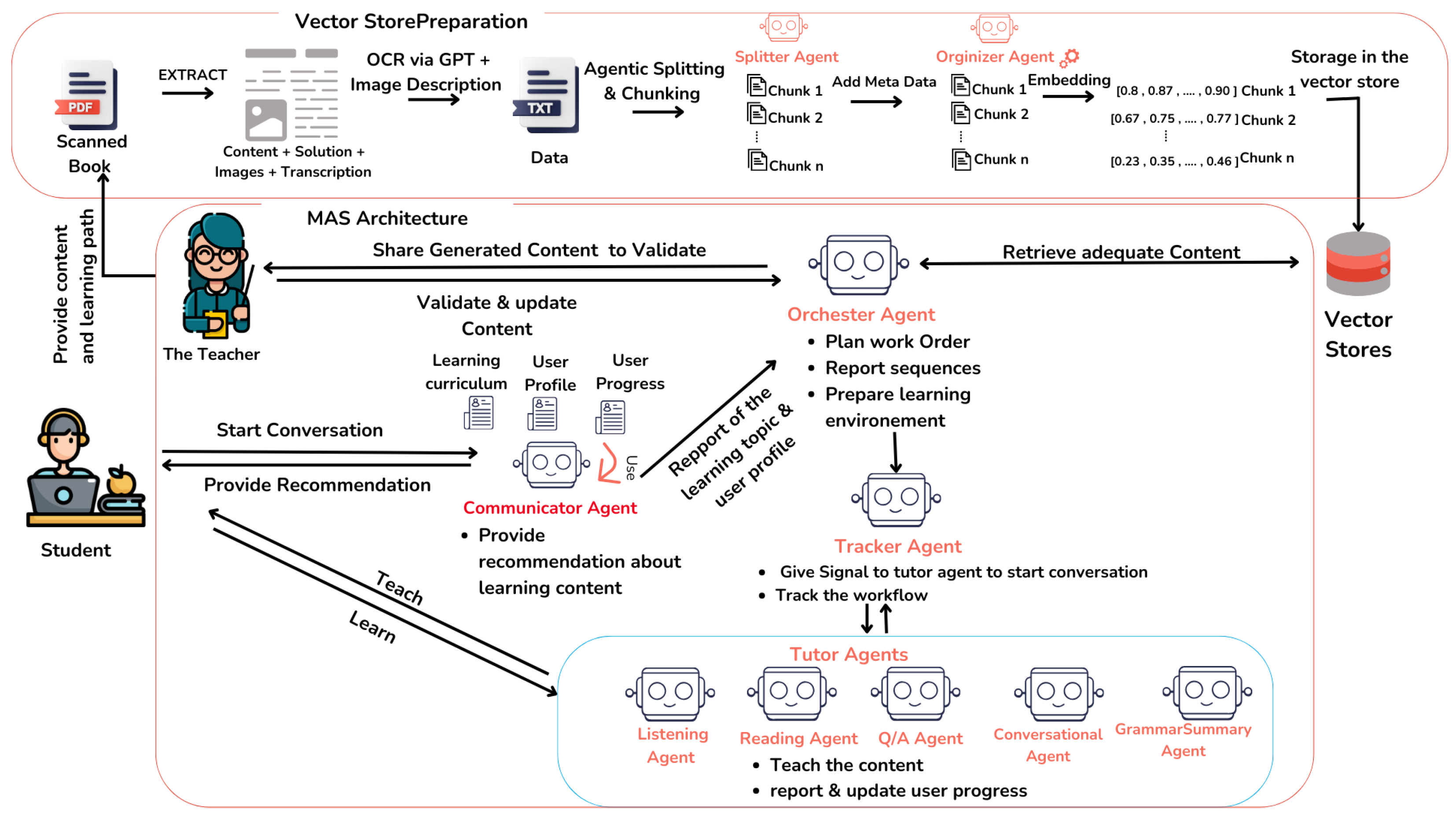
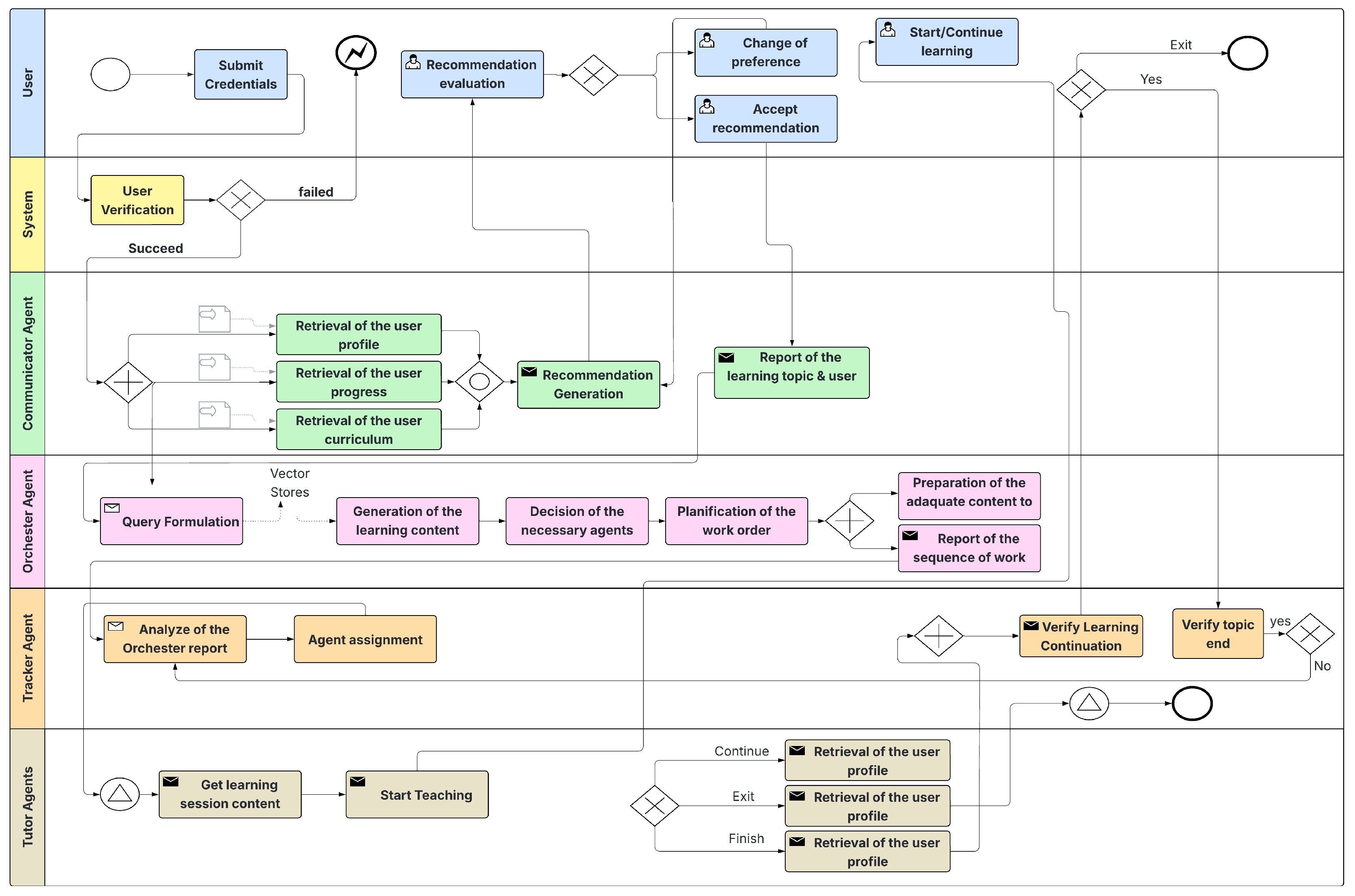
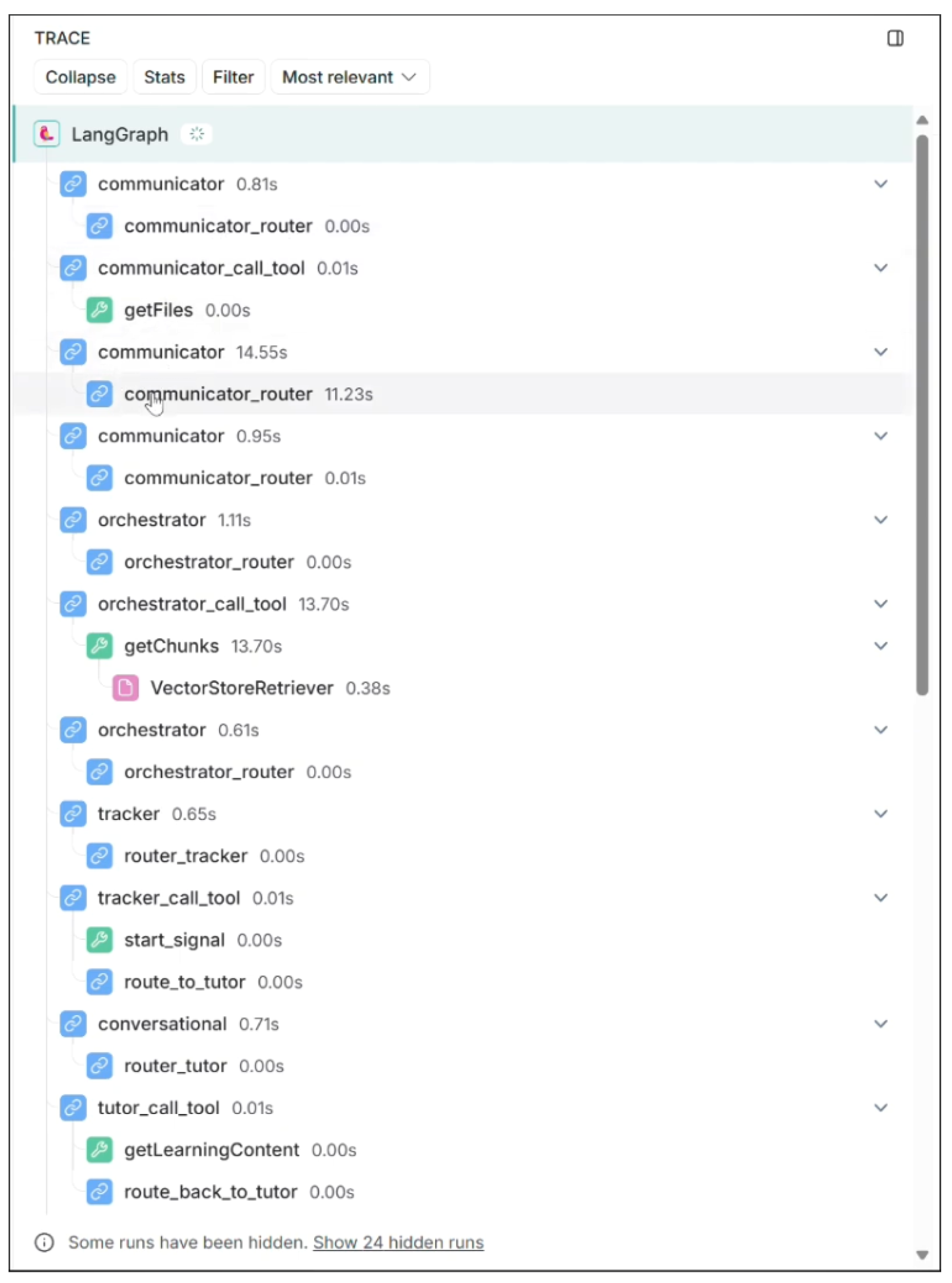
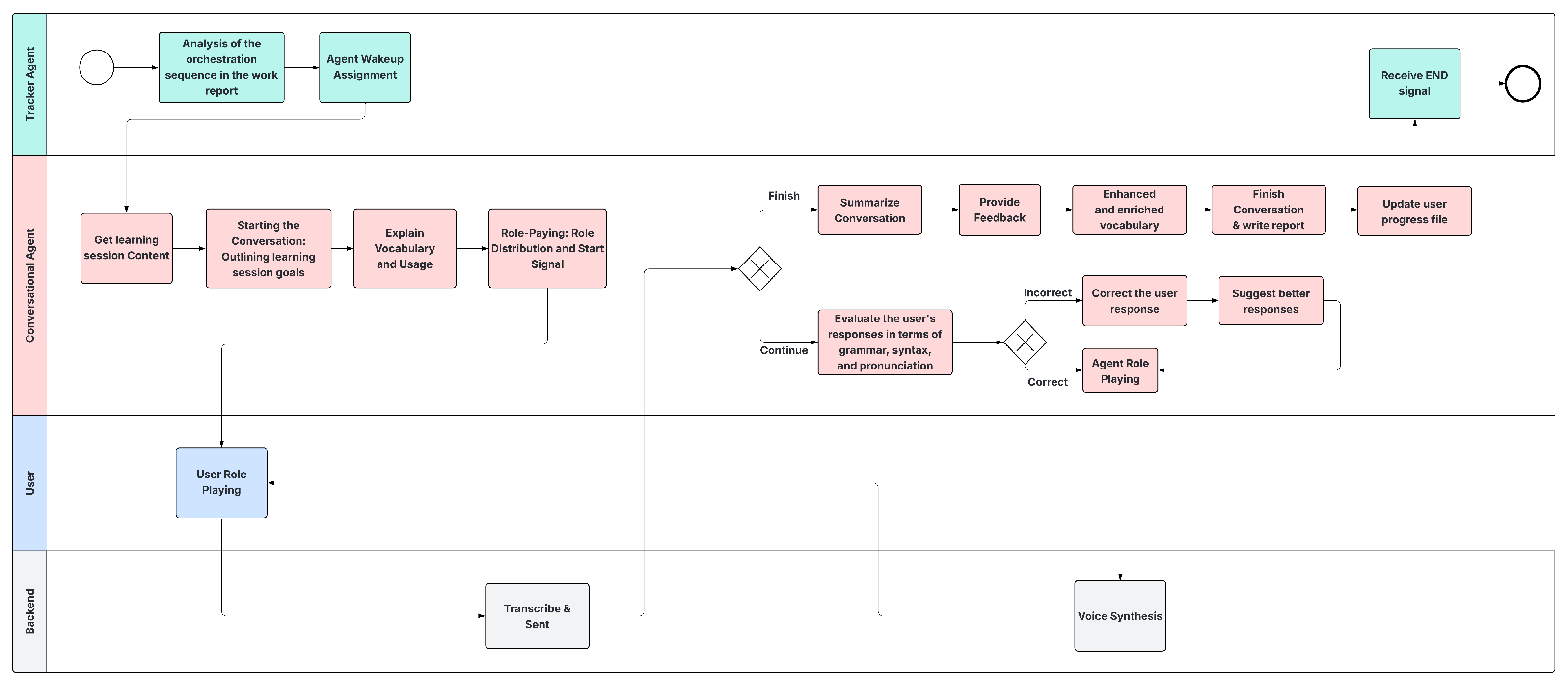
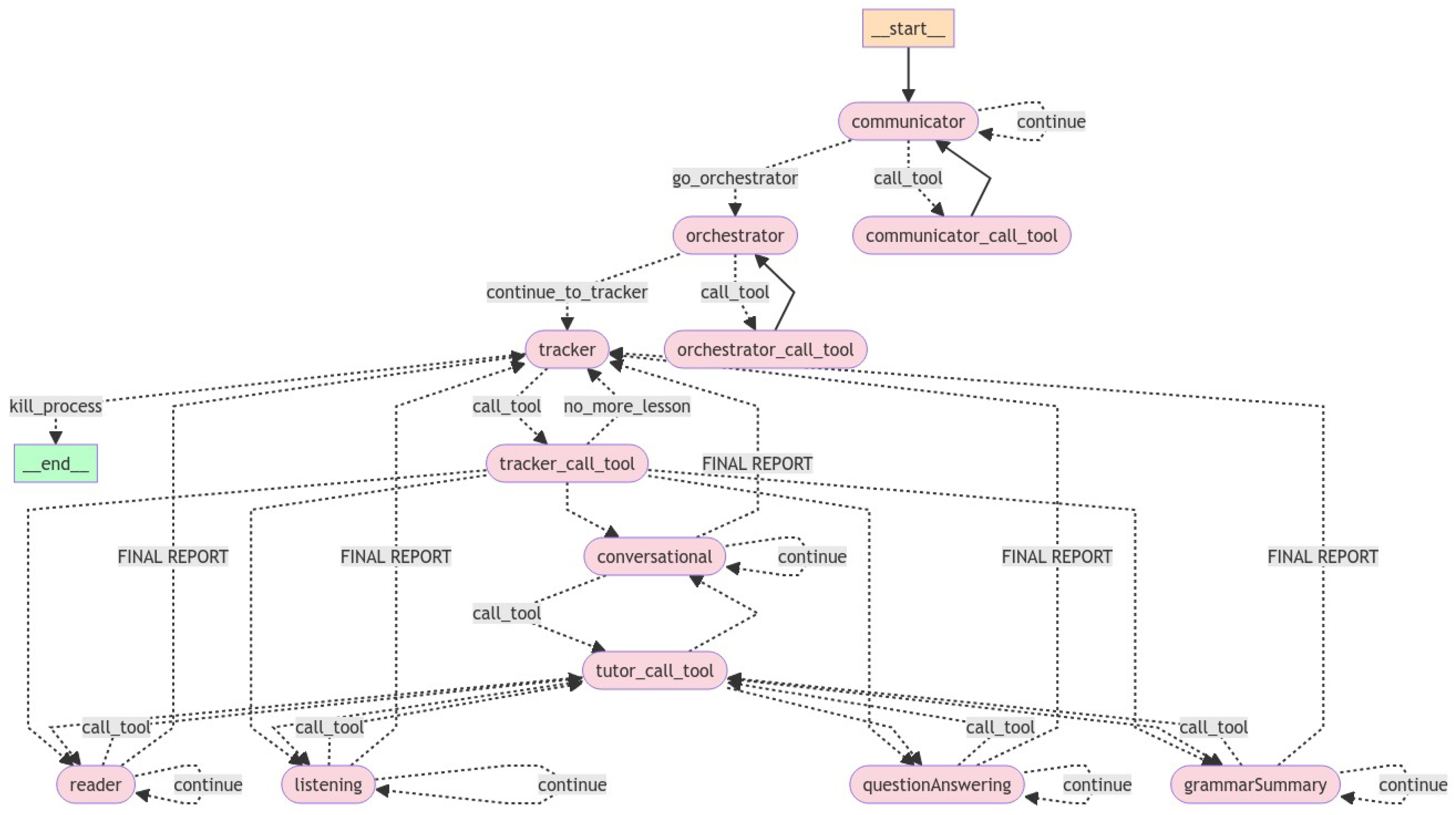
| Pool/Lane | Role/Responsibility |
|---|---|
| User | Human learner interacting via the UI. |
| Communicator Agent | Retrieves profile data; proposes personalized learning paths; emits RAG queries. |
| Orchestrator Agent | Fetches and validates content; plans which tutor agents to invoke and in what order. |
| Tracker Agent | Drives step-by-step activation of tutor agents; logs completion or early-exit signals. |
| Tutor Agents | Swimlane for specialized tutors (Conversation, Reading, Listening, QA, Grammar Summary). |
| Gateway ID | Condition and Action |
|---|---|
| G1 (Correct?) | IF pronunciation_error_count = 0 → advance to next dialogue turn; ELSE → invoke corrective feedback task and loop back. |
| G2 (All Turns Completed?) | IF turns_completed = total_turns → proceed to Wrap-Up; ELSE → return to Role-Play Loop. |
| BPMN Element | LangGraph Concept | MAS Component | Function |
|---|---|---|---|
| Pool | Agent Node | Agent Class | Encapsulates a high-level role (e.g., Communicator, Orchestrator) |
| Lane | Tool Node | Agent Capability | Provides an external service or helper (e.g., getFiles) |
| Task | Task Node | Method Invocation | Executes a concrete operation (e.g., generateRecommendation) |
| Gateway | Router | Routing Logic | Evaluates conditions and selects outgoing edge |
| Data Object | State Variable | Memory Store | Holds persistent data (user profile, progress, curriculum) |
| Message Flow | Message Edge | Inter-Agent Message | Transmits data or control between agents |
| Model | Pretraining | Fine-Tuning Data | WER |
|---|---|---|---|
| wav2vec2-large-xlsr-53-842h-luxembourgish-14h | Multilingual (53 langs) | 842 h unlabeled + 14 h labeled | 28% |
| whisper_large_lb_ZLS_v4_38h | OpenAI Whisper base | 14 h → 38 h labeled Luxembourgish | 18% |
| Metric | Score |
|---|---|
| Context Relevancy | 0.87 |
| Faithfulness | 0.82 |
| Answer Relevancy | 0.85 |
| Question | Response Distribution |
|---|---|
| Ease of Interaction | Very Easy (42.9%), Easy (42.9%), Difficult (14.3%) |
| Satisfaction with Understanding and Contextual Responses | Satisfied (42.9%), Very Satisfied (28.6%), Neutral (28.6%) |
| Engagement Level | Very engaging (71.4%), Moderately engaging (28.6%) |
| Likelihood to Continue | Likely (71.4%), Very Likely (14.3%), Neutral (14.3%) |
Disclaimer/Publisher’s Note: The statements, opinions and data contained in all publications are solely those of the individual author(s) and contributor(s) and not of MDPI and/or the editor(s). MDPI and/or the editor(s) disclaim responsibility for any injury to people or property resulting from any ideas, methods, instructions or products referred to in the content. |
© 2025 by the authors. Licensee MDPI, Basel, Switzerland. This article is an open access article distributed under the terms and conditions of the Creative Commons Attribution (CC BY) license (https://creativecommons.org/licenses/by/4.0/).
Share and Cite
Tebourbi, H.; Nouzri, S.; Mualla, Y.; El Fatimi, M.; Najjar, A.; Abbas-Turki, A.; Dridi, M. BPMN-Based Design of Multi-Agent Systems: Personalized Language Learning Workflow Automation with RAG-Enhanced Knowledge Access. Information 2025, 16, 809. https://doi.org/10.3390/info16090809
Tebourbi H, Nouzri S, Mualla Y, El Fatimi M, Najjar A, Abbas-Turki A, Dridi M. BPMN-Based Design of Multi-Agent Systems: Personalized Language Learning Workflow Automation with RAG-Enhanced Knowledge Access. Information. 2025; 16(9):809. https://doi.org/10.3390/info16090809
Chicago/Turabian StyleTebourbi, Hedi, Sana Nouzri, Yazan Mualla, Meryem El Fatimi, Amro Najjar, Abdeljalil Abbas-Turki, and Mahjoub Dridi. 2025. "BPMN-Based Design of Multi-Agent Systems: Personalized Language Learning Workflow Automation with RAG-Enhanced Knowledge Access" Information 16, no. 9: 809. https://doi.org/10.3390/info16090809
APA StyleTebourbi, H., Nouzri, S., Mualla, Y., El Fatimi, M., Najjar, A., Abbas-Turki, A., & Dridi, M. (2025). BPMN-Based Design of Multi-Agent Systems: Personalized Language Learning Workflow Automation with RAG-Enhanced Knowledge Access. Information, 16(9), 809. https://doi.org/10.3390/info16090809










